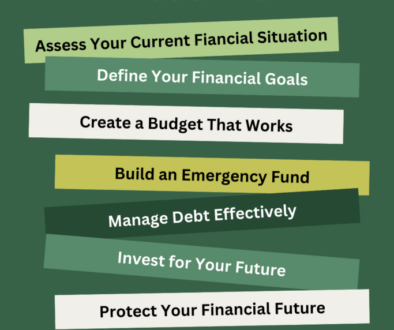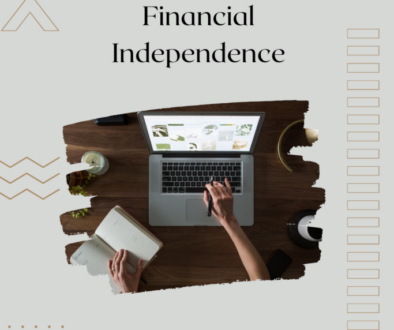Emergency Fund 101: How to Build, Grow, and Use It Wisely
Why an Emergency Fund Is a Financial Necessity
Life is unpredictable, and financial surprises are inevitable—but the right preparation can make all the difference. An emergency fund is a crucial financial safety net that protects you from unexpected expenses, such as medical bills, car repairs, or sudden job loss. Without one, a minor setback can quickly spiral into a significant financial crisis.
In this comprehensive guide, we will explore the importance of an emergency fund, how much you should save, the best places to store it, and practical steps to build one efficiently. By the end, you’ll understand why an emergency fund is the foundation of financial stability and how to make it work for you.
1. Understanding the Role of an Emergency Fund
1.1 What Is an Emergency Fund?
An emergency fund is a dedicated savings account designed to cover unexpected financial setbacks, such as medical bills, car repairs, or job loss. Unlike general savings or investment accounts, this fund serves as a financial buffer, allowing you to handle emergencies without going into debt or depleting other financial resources.
Having a separate fund for emergencies ensures that you do not have to rely on credit cards or high-interest loans during financial crises. This fund acts as a financial lifeline, enabling you to navigate life’s uncertainties with greater confidence. Without it, even small financial disruptions can derail long-term financial plans and lead to unnecessary stress.
1.2 Why an Emergency Fund Is Essential
Without a financial safety net, even a small unexpected expense can turn into a major financial crisis. Imagine losing your job and not having enough savings to cover your rent, utilities, or groceries. Many people resort to credit cards or loans, leading to high-interest debt that can be difficult to escape. An emergency fund provides a cushion, allowing you to manage financial shocks without relying on borrowing.
In addition to protecting against debt accumulation, an emergency fund ensures you do not have to liquidate investments or disrupt other financial goals. It allows you to maintain financial independence and stability while dealing with unexpected expenses, keeping you on track toward long-term financial growth.
1.3 The Psychological Benefits of Having an Emergency Fund
Financial stress can take a toll on mental health, but having an emergency fund provides peace of mind and confidence. Studies show that people with emergency savings experience lower levels of financial anxiety and greater overall well-being. Knowing that you have a safety net in place reduces stress and allows you to focus on long-term financial goals.
Beyond the practical benefits, having a dedicated emergency fund fosters a sense of financial control. When you know you have the means to handle life’s uncertainties, you gain greater confidence in your financial decisions. This security encourages proactive financial planning and helps develop healthy saving habits that support overall financial well-being.
2. How Much Should You Save in an Emergency Fund?
2.1 The General Rule: 3 to 6 Months of Expenses
Experts typically recommend saving enough to cover three to six months of essential expenses. This includes rent or mortgage payments, utilities, groceries, insurance, and any loan payments. The goal is to have enough saved to maintain your standard of living in case of unexpected financial hardships.
Having three to six months’ worth of savings provides flexibility during financial disruptions. It buys you time to recover from setbacks, such as finding a new job or addressing an urgent medical issue, without resorting to debt. The key is to ensure that your emergency fund covers all essential needs, including healthcare, transportation, and other critical living expenses.
2.2 Factors That Determine Your Ideal Emergency Fund Size
Not everyone needs the same emergency fund—your lifestyle, job security, and obligations play a key role in deciding the right amount. If you have a stable job with reliable income, three months of expenses may be sufficient. However, freelancers, business owners, and gig workers should aim for a larger emergency fund since their income is less predictable. Additionally, those with dependents or high medical expenses should consider saving more.
Other considerations include your debt level and existing financial obligations. If you have significant debt payments, a larger emergency fund can help you stay current on obligations even during tough times. Likewise, if you live in an area with high living costs, an adequately funded emergency account is crucial to maintaining financial security.
2.3 When a Larger Emergency Fund Might Be Necessary
Some situations call for an extra financial cushion beyond the standard recommendation. If you are self-employed, work in an unstable industry, or live in an area prone to natural disasters, having six to twelve months of expenses saved can provide additional security. Similarly, if you have significant health concerns, a larger emergency fund can help cover unexpected medical costs.
Individuals planning for major life changes, such as relocating, starting a family, or switching careers, should consider an extended emergency fund. These transitions often come with hidden costs, and having a more substantial financial cushion ensures you can adapt smoothly without financial strain.
3. Where to Keep Your Emergency Fund
3.1 The Best Accounts for an Emergency Fund
Liquidity and accessibility are key—your emergency fund should be easy to access without penalties or delays. High-yield savings accounts are an excellent option because they offer liquidity while earning some interest. Money market accounts and no-penalty certificates of deposit (CDs) are also good choices, as they provide better returns than traditional savings accounts while maintaining accessibility.
By choosing a high-yield account, you ensure your money is not only safe but also growing over time. While the interest earned may not be substantial, it helps offset inflation and keeps your savings working for you. Additionally, maintaining a separate emergency fund account prevents you from accidentally spending the money on non-emergency expenses.
3.2 Where NOT to Keep Your Emergency Fund
Investing your emergency fund might seem tempting, but it could leave you exposed in a financial emergency. Stocks and volatile investments can lose value, making them unsuitable for emergency savings. Additionally, keeping your emergency fund in a checking account may lead to unintentional spending, reducing its effectiveness as a safety net.
Some individuals are tempted to place emergency savings in retirement accounts, but this is not advisable due to withdrawal penalties and tax implications. The key principle of an emergency fund is accessibility, so keeping it in a place where you can withdraw funds instantly, without penalties, is essential.
3.3 Balancing Accessibility and Growth
While liquidity is essential, maximizing returns without compromising accessibility is ideal. A tiered strategy can help balance these factors effectively. For instance, keeping one month’s worth of expenses in a regular savings account ensures instant access, while the remainder can be stored in a high-yield savings or money market account to earn interest. Consider options such as high-yield savings accounts, money market accounts, and no-penalty certificates of deposit (CDs) to optimize both safety and returns.
This approach allows you to meet immediate financial needs while also protecting your savings from inflation. By strategically dividing your emergency fund, you can ensure that the money remains both accessible and productive, serving its purpose without being eroded by rising costs over time. Additionally, researching and comparing interest rates across financial institutions can help maximize growth while keeping funds secure.
4. How to Build an Emergency Fund: Step-by-Step Guide
4.1 Setting a Realistic Savings Goal
The first step in building an emergency fund is determining a target amount based on your essential expenses. Start by calculating your monthly necessities, including housing, food, transportation, insurance, and debt payments. Multiply this by your desired number of months to establish a clear savings goal. Most financial experts recommend saving at least three to six months’ worth of living expenses.
Once you have a target in mind, break it down into smaller, manageable milestones. Rather than feeling overwhelmed by the total amount, focus on saving one month’s worth first, then gradually increase it. Setting achievable goals will keep you motivated and make the process feel more attainable. Use online savings calculators or budgeting apps to track your progress effectively.
4.2 Automating Your Savings
One of the easiest ways to build an emergency fund is to automate contributions. Setting up automatic transfers from your paycheck or checking account to a designated savings account ensures consistent progress. This removes the temptation to spend the money elsewhere and turns saving into a habit. Many banks offer the ability to set up recurring transfers, which simplifies the process.
Even small, regular contributions can add up over time. If possible, allocate a percentage of your income, such as 10%, to your emergency fund. If that’s not feasible, start with a smaller amount and gradually increase it as your financial situation improves. Automating savings creates financial discipline without requiring constant effort.
4.3 Cutting Expenses to Boost Savings
If saving feels difficult due to financial constraints, consider trimming discretionary expenses. Analyze your spending habits and identify areas where you can cut back—whether it’s dining out less frequently, canceling unused subscriptions, or finding more cost-effective alternatives for everyday expenses. Even a small reduction in spending can significantly impact your savings over time.
Redirecting these savings into your emergency fund can accelerate your progress without requiring significant lifestyle changes. Even small adjustments, such as brewing coffee at home instead of buying it daily, can make a meaningful difference over time. Using expense-tracking apps can help identify unnecessary spending habits and make saving more manageable.
4.4 Increasing Income to Accelerate Savings
While reducing expenses is effective, increasing your income can fast-track your emergency fund growth. Consider taking on freelance work, a side hustle, or selling unused items to generate extra cash. These additional earnings can be directly allocated to your emergency fund without affecting your regular budget. Popular side hustles include online tutoring, ride-sharing, and e-commerce.
Additionally, if you receive unexpected windfalls—such as a tax refund, work bonus, or monetary gift—prioritize saving a portion of it. Using extra income wisely can help you reach your emergency fund goal much faster. Treating these one-time gains as an opportunity to strengthen your financial security will pay off in the long run.
4.5 Staying Consistent and Avoiding Temptation
Consistency is key when building an emergency fund. Regularly reviewing your progress and making adjustments as needed ensures you stay on track. Celebrate small milestones to stay motivated and remind yourself of the long-term benefits of having a safety net. Tracking your progress through financial apps or a savings journal can help maintain focus.
It’s also crucial to avoid dipping into your emergency fund for non-essential expenses. Define what constitutes a true emergency and resist the urge to use the fund for discretionary purchases. Keeping your financial discipline intact will ensure that the fund is available when you need it most. Consider labeling your emergency fund as “Do Not Touch” in your banking app to reinforce its purpose.
5. When and How to Use Your Emergency Fund Wisely
5.1 Identifying a True Financial Emergency
Not every unexpected expense qualifies as an emergency. A financial emergency is typically an essential, urgent, and unavoidable expense, such as medical bills, necessary car repairs, or covering living expenses during a job loss. If an expense does not meet these criteria, it may be best to use other funds or budget accordingly.
Defining clear guidelines for using your emergency fund helps prevent unnecessary withdrawals. Ask yourself whether the expense is unexpected and unavoidable. If the answer is yes, using your emergency fund is appropriate; otherwise, consider alternative payment methods. Avoid depleting your fund for non-essential expenses like vacations, luxury purchases, or impulse spending.
5.2 Replenishing Your Emergency Fund After Use
Once you use your emergency fund, rebuilding it should become a priority. Resume automated savings as soon as possible and allocate any additional income toward replenishing the fund. Treat it as a non-negotiable financial commitment, just like paying a bill. The sooner you replenish your fund, the better protected you will be against future financial setbacks.
If possible, adjust your budget temporarily to increase savings contributions until the fund is restored. The faster you replenish your emergency savings, the better prepared you’ll be for future financial surprises. Consider making small lifestyle changes, such as cooking at home more often or temporarily reducing entertainment expenses, to rebuild your safety net quickly.
6. Take Control of Your Financial Future with an Emergency Fund
An emergency fund is more than just a savings account—it’s a financial lifeline that provides security, stability, and peace of mind. Whether you’re facing unexpected medical expenses, job loss, or urgent home repairs, having a well-funded emergency reserve allows you to navigate life’s uncertainties without financial distress. It serves as your first line of defense against debt and financial hardship.
Building an emergency fund takes time and discipline, but the benefits far outweigh the effort. By setting a clear savings goal, automating contributions, and practicing financial discipline, you can create a strong safety net that protects you from life’s financial surprises. Start today, and take control of your financial future with confidence. The sooner you begin, the stronger your financial foundation will be.





